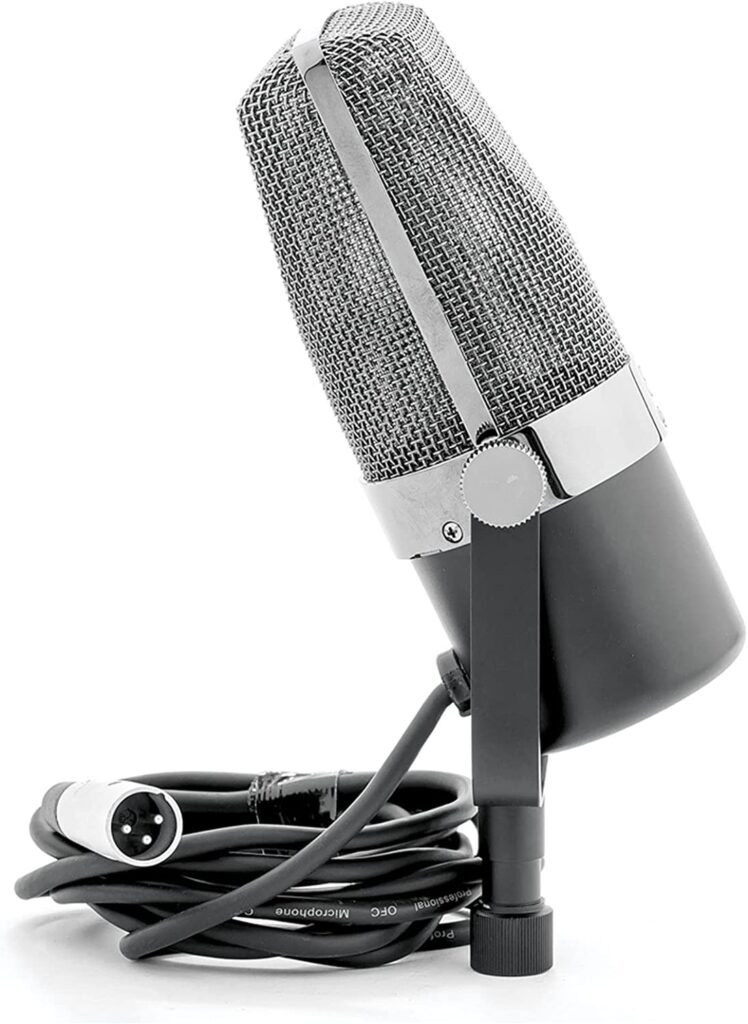A thin strip of metal or ribbon is used as the diaphragm in a dynamic ribbon microphone to pick up sound. Dynamic ribbon microphones are known for their warm, smooth sound and ability to pick up small details and nuances in the recorded sound.
Features of a dynamic ribbon microphone
- Directional pattern: Most dynamic ribbon microphones have a figure-8 or bidirectional polar pattern, which means they pick up sounds best from the front and back of the microphone and less well from the sides.
- Frequency response: The frequency response of most dynamic ribbon microphones is smooth and long, with a slight boost in the low-mid and low frequencies. This gives them a warm, full sound that works well for recording vocals and instruments with a natural sound.
- Sensitivity: Dynamic ribbon microphones are generally less sensitive than other microphones. This means that they may need more signals to make a strong output. In a live performance setting, this can make them less sensitive to background noise and more resistant to feedback.
- Durability: Dynamic ribbon microphones are generally more rugged and long-lasting than other microphones. This makes them a good choice for live performances.
- Cost: Dynamic ribbon microphones are generally less expensive than other microphones, which is why many musicians and recording professionals choose them.
Pros of a dynamic ribbon microphone
Here are some potential advantages of using a dynamic ribbon microphone
- Warm, smooth sound: Dynamic ribbon microphones are known for their warm, soft sound, which works well for recording vocals and acoustic instruments.
- Excellent at capturing subtle details: Dynamic ribbon microphones are very sensitive to fine details and nuances in the sound they are recording. This makes them great for capturing the subtleties of performance.
- Durable: Dynamic ribbon microphones tend to be more rugged and long-lasting than other microphones, making them a good choice for live performances.
- Good at reducing background noise: Dynamic ribbon microphones are generally less sensitive than other microphones. This makes them less sensitive to background noise and more resistant to feedback when used live.
- Affordable: Dynamic ribbon microphones tend to be less expensive than other microphones, which is why many musicians and recording professionals choose to use them.
Cons of a dynamic ribbon microphone
Here are some potential drawbacks to using a dynamic ribbon microphone:
- Limited frequency response: Compared to other types of microphones, dynamic ribbon microphones tend to have a limited frequency response, making them less useful in some situations.
- Less sensitive: Dynamic ribbon microphones are generally less sensitive than other microphones. You may need to use a preamp or another signal booster to get a strong output.
- Fragile: Even though dynamic ribbon microphones are usually more sturdy and long-lasting than other types, the ribbon itself can be fragile and easily damaged if not handled with care.
- Limited directional pattern: Dynamic ribbon microphones usually have a figure-8 polar pattern, which means they are most sensitive to sounds coming from the front and back of the microphone and less sensitive to sounds coming from the sides. In some recording situations, this can make it harder for them to pick a specific sound source.
- Not suitable for all recording situations: Dynamic ribbon microphones may not be the best choice for recording certain instruments or when a high level of sensitivity is needed.
What is the primary directional pattern of most dynamic ribbon microphones, and how does it affect their sound pickup?
Most dynamic ribbon microphones have a figure-8 or bidirectional polar pattern, which means they pick up sounds best from the front and back of the microphone and less well from the sides. This pattern affects how they capture sound sources.
What type of sound sources are dynamic ribbon microphones well-suited for?
Dynamic ribbon microphones excel at capturing vocals and acoustic instruments with a natural, warm, and smooth sound. They are also known for their ability to capture subtle details and nuances in performances.
Do dynamic ribbon microphones require additional signal amplification?
Yes, dynamic ribbon microphones are generally less sensitive than other microphones, so they may require a preamplifier or signal booster to achieve a strong output, especially in recording situations.
Are dynamic ribbon microphones suitable for live performances?
Yes, dynamic ribbon microphones are a good choice for live performances due to their durability, reduced sensitivity to background noise, and resistance to feedback.
What are some limitations of dynamic ribbon microphones?
Dynamic ribbon microphones have a limited frequency response compared to other microphones, and their figure-8 polar pattern may make it harder to isolate specific sound sources in certain recording situations. Additionally, the ribbon itself can be fragile and easily damaged if not handled with care.




